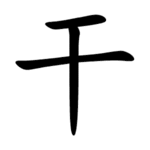Radical 51
Radical 51 (干 Unicode U+5E72, pinyin gān meaning "oppose" or "dried") is one of 31 out of the total 214 Kangxi radicals written with three strokes.
| 干 | ||
|---|---|---|
| ||
| 干 (U+5E72) "oppose, dried" | ||
| Pinyin: | gān | |
| Bopomofo: | ㄍㄢ | |
| Gwoyeu Romatzyh: | gan | |
| Wade–Giles: | kan1 | |
| Cantonese Yale: | gōn | |
| Jyutping: | gon1 | |
| Pe̍h-ōe-jī: | kan | |
| Kana: | かん, ほす kan, hosu | |
| Kanji: | 干 hosu | |
| Hangul: | 방패 banpae | |
| Sino-Korean: | 간 gan | |
| Stroke order animation | ||
 | ||
There are only nine characters derived from this radical, and some modern dictionaries have discontinued its use as a section header. In such characters that are derived from it, it mostly takes a purely phonetic role, as in 肝 "liver".
In origin, the character depicts a kind of fork used as a weapon used in hunting or in warfare, or alternatively either a pestle or a shield. It can be traced to the seal script.
In simplified Chinese
As a character (not a radical), 干 has risen to new importance, and even notoriety due to the 20th-century Chinese writing reform. In simplified Chinese, 干 takes the place of a number of other characters with the phonetic value gān or gàn, e.g. of 乾 "dry" or 幹 "trunk, body", so that 干 may today take a wide variety of meanings.
The high frequency and polysemy of the character poses a serious problem for Chinese translation software. The word 幹 gàn "tree trunk; to do" (rarely also "human body"), rendered as 干 in simplified Chinese, acquired the meaning of "to fuck" in Chinese slang. Notoriously, the 2002 edition of the widespread Jinshan Ciba Chinese-to-English dictionary for the Jinshan Kuaiyi translation software rendered every occurrence of 干 as "fuck", resulting in a large number of signs with irritating English translations throughout China, often mistranslating 乾 gān "dried" as in 干果 "dried fruit" in supermarkets as "fuck the fruits" or similar.[1]
Derived characters
 Bronze script character
Bronze script character Large Seal Script character
Large Seal Script character Small Seal Script character
Small Seal Script character
| Strokes | Characters |
|---|---|
| + 0 | 干 |
| + 2 | 平 |
| + 3 | 年 幵 并 |
| + 5 | 幷 幸 |
| +10 | 幹 |
Literature
- Fazzioli, Edoardo (1987). Chinese calligraphy : from pictograph to ideogram : the history of 214 essential Chinese/Japanese characters. calligraphy by Rebecca Hon Ko. New York: Abbeville Press. ISBN 0-89659-774-1.
- Leyi Li: “Tracing the Roots of Chinese Characters: 500 Cases”. Beijing 1993, ISBN 978-7-5619-0204-2
- Rick Harbaugh, Chinese Characters: A Genealogy and Dictionary, Yale University Press (1998), ISBN 978-0-9660750-0-7.
References
- Victor Mair, The Etiology and Elaboration of a Flagrant Mistranslation, Language Log, December 2007.